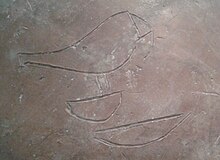Iry-Hor
| Iry-Hor | |
|---|---|
| Ro, Irj-Hor, Iri(-Hor) | |

Signs r-Ḥr inscribed on a large vessel from the tomb of Iry-Hor, Ashmolean Museum.
|
|
| Pharaoh | |
| Reign | Early to Late 32nd century BC(Dynasty 0) |
| Predecessor | Scorpion I ? Double Falcon ? |
| Successor | Uncertain, possibly Ka |
| Burial | Chambers B1, B2, Umm el-Qa'ab |
Iry-Hor or Ro (as read by the Egyptologist Flinders Petrie) was a predynastic pharaoh of Upper Egypt during the 32nd century BC. Until recently, Iry-Hor's existence was debated, with the Egyptologist Toby Wilkinson contesting the reading and signification of his name. However, continuing excavations at Abydos in the 1980s and 1990s and the discovery in 2012 of an inscription of Iry-Hor in the Sinai confirmed his existence. Iry-Hor is the earliest ruler of Egypt known by name and possibly the earliest historical person known by name.
Iry-Hor's name is written with the Horus falcon hieroglyph (Gardiner sign G5) above a mouth hieroglyph (Gardiner D21). While the modern reading of the name is "Iry-Hor", Flinders Petrie, who discovered and excavated Iry-Hor's tomb at the end of the 19th century, read it "Ro", which was the usual reading of the mouth hieroglyph at the time. Given the archaic nature of the name, the translation proved difficult and, in the absence of better alternative, Ludwig D. Morenz proposed that the literal translation be retained giving "Horus mouth". In the 1990s, Werner Kaiser and Günter Dreyer translate Iry-Hor's name as "Companion of Horus".Toby Wilkinson, who contested that Iry-Hor was a king, translated the signs as "Property of the king". Following the excavations at Abydos and the discovery of an inscription of Iry-Hor in the Sinai in 2012, Wilkinson's hypothesis is now rejected by most Egyptologists and Iry-Hor is widely accepted as a predynastic king of Egypt.
The Egyptologists Jürgen von Beckerath and Peter Kaplony also initially rejected the identification of Iry-Hor as a king and proposed instead that the known inscriptions refer to a private person whose name is to be read Wer-Ra, wr-r3 (lit. "Great mouth"), i.e. reading the bird above the mouth-sign as the swallow hieroglyph G36 rather than the Horus falcon. They translated the name as "Spokesman" or "Chief". However, continuing excavations of Iry-Hor's tomb at Abydos by Günter Dreyer established that the tomb was of similar dimensions and layout as those of Ka and Narmer and must therefore have belonged to a king. This was consequently accepted by von Beckerath and Iry-Hor is now the first entry in the latest edition of von Beckerath's Handbook of Egyptian Pharaohs.
...
Wikipedia
